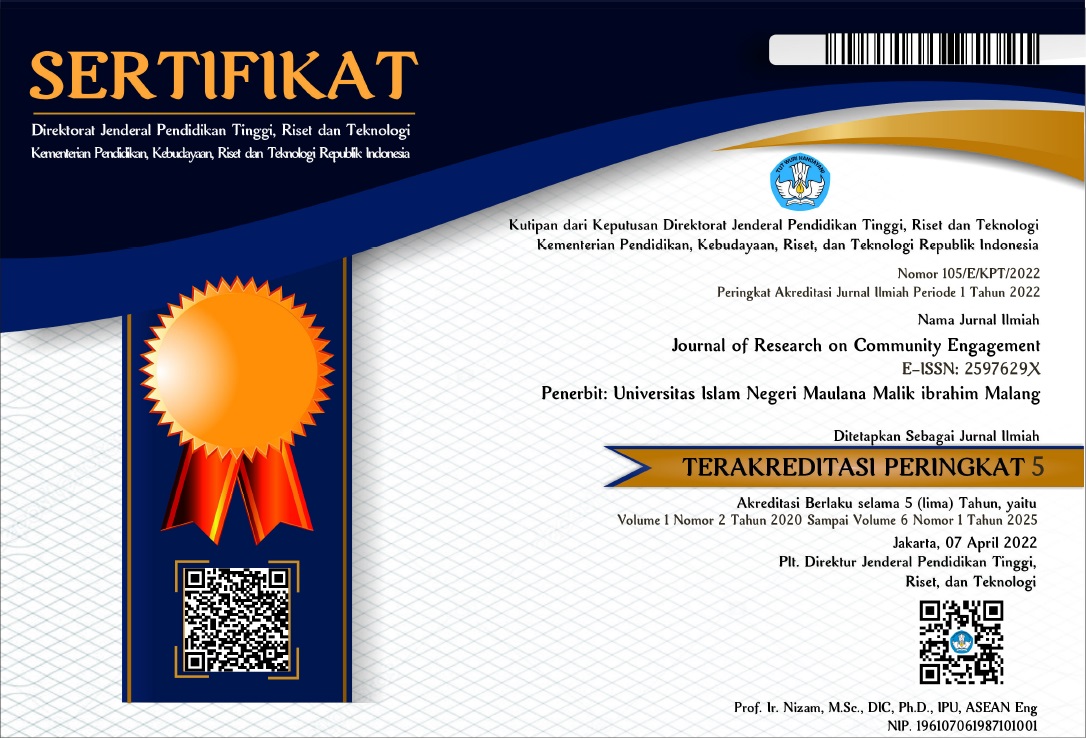Program Bangun Duniamu: Peningkatan Keterampilan Spasial Siswa Tunanetra Melalui Media Pembelajaran Denah
Abstract
Full Text:
PDFReferences
[1] Yudhiastuti, A., & Azizah, N, “Pembelajaran Program Khusus Orientasi Mobilitas Bagi Peserta Didik Tunanetra di Sekolah Luar Biasa” PEMBELAJAR: Jurnal Ilmu Pendidikan, Keguruan, dan Pembelajaran, 3(1), 1-8, 2019.
[2] Chang, K., Dillon, L., Deverell, L., Boon, M. Y., & Keay, L, “Orientation and Mobility Outcome Measures,” Clinical and Expierimental Optometry, 103(4), 434–448, 2020.
[3] Davtyan, S, “Spacial Orientation of Children with Visual Impairments,” Armenian Journal of Special Education, 4(2), 90–96, 2020.
[4] Pambudi, M. R., & Masruroh, “Efektifitas Model Pembelajaran Berbasis Spasial Terhadap Hasil Belajar Siswa,” Paedagoria: Jurnal Kajian, Penelitian dan Pengembangan Kependidikan, 14(02), 161–165, 2023.
[5] Yaum, L. A, “Metode Pembelajaran Berbasis Outbond Terhadap Hasil Belajar Mata Kuliah Orientasi Mobilitas.’ Jurnal ORTOPEDAGOGIA, 7(1), 49–52, 2021.
[6] Elva, & Budiyuwono, H, “Role of Physical Environment To Orientation and Mobility of Blind in Psbn Wyata Guna Bandung,” Riset Arsitektur (RISA), 2(4), 412–431, 2018.
[7] Febriani, A., Fiantika, F., & Rusminati, S, “Studi Representasi Kemampuan Berpikir Spasial melalui Realistic Mathematic Education pada Siswa Sekolah Datar,” Jurnal Ilmiah Wahana Pendidikan, 10(9), 9–17, 2018.
[8] Toyoda, W., Tani, E., Oouchi, S., & Ogata, M, “Effects of environmental explanation using three-dimensional tactile maps for orientation and mobility training,” Applied Ergonomics, 88, Article 103177, 2020.
[9] Holloway, L., Marriott, K., & Butler, M, “Accessible maps for the blind: Comparing 3D printed models with tactile graphics,” Conference on Human Factors in Computing Systems-Proceedings, 198, 1–13, 2018.
[10] Rachmawati, S, “Penggunaan Media Block Card Untuk Meningkatkan KemampuanMembaca Dan Membuat Denah Pada Siswa Tunanetra,” 23(2), 106–121, 2014.
[11] Elan, Abdul, M., Dindin, L., & Nurlela, A, “Analisis Penggunaan Media Wooden Building Blocks untuk Kecerdasan Visual-Spasial dalam Mengenal Bentuk Geometri,” Jurnal Cikal Cendekia, 3(1), 38–49, 2022.
[12] Jakiyudin, A. H., Yusuf, M., Iribaram, S., Nawir, M., & Muhandy, R, “Pemberdayaan Mama-Mama Melalui Produk Abon Ikan Lilinta (ABOLI) Berbasis Industri Rumahan Di Kampung Lilinta, Distrik Misool Barat, Kabupaten Raja Ampat,” Jurnal Pengabdian Pada Masyarakat, 8(2), 275–284, 2023.
DOI: https://doi.org/10.18860/jrce.v6i2.31691
Refbacks
- There are currently no refbacks.
Copyright (c) 2025 Imam Rofiki

This work is licensed under a Creative Commons Attribution-ShareAlike 4.0 International License.




.jpg)